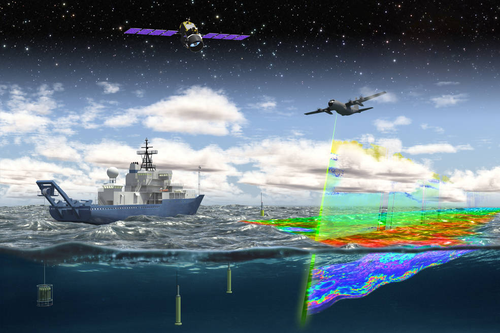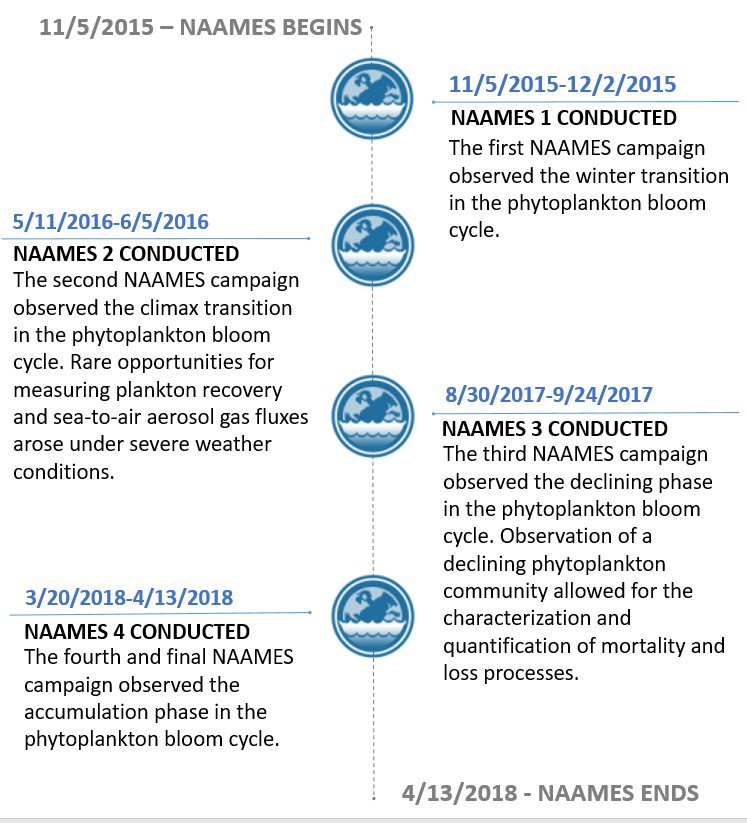A Look into the North Atlantic Aerosols and Marine Ecosystems Study (NAAMES)
A Look into the North Atlantic Aerosols and Marine Ecosystems Study (NAAMES)
- The NASA North Atlantic Aerosols and Marine Ecosystems Study (NAAMES) project was the first NASA Earth Venture – Suborbital mission focused on studying the coupled ocean ecosystem and atmosphere. NAAMES utilizes a combination of ship-based, airborne, autonomous sensor, and remote sensing measurements that directly link ocean ecosystem processes, emissions of ocean-generated aerosols and precursor gases, and subsequent atmospheric evolution and processing. Four deployments coincide with the seasonal cycle of phytoplankton in the North Atlantic Ocean: the Winter Transition (November 5 – December 2, 2015), the Bloom Climax (May 11 – June 5, 2016), the Deceleration Phase (August 30 – September 24, 2017), and the Acceleration Phase (March 20 – April 13, 2018). Ship-based measurements were conducted from the Woods Hole Oceanographic Institution Research Vessel Atlantis in a region of the North Atlantic Ocean south of Greenland, while airborne measurements were conducted on a NASA Wallops Flight Facility C-130 Hercules, that was based at St. John's International Airport, Newfoundland, Canada. Data products in the ASDC archive focus on the NAAMES atmospheric aerosol, cloud, and trace gas data from the ship and aircraft, as well as related satellite and model data subsets. While a few ocean-remote sensing data products (e.g., from the high-spectral resolution lidar) are also included in the ASDC archive, most ocean data products reside in a companion archive at SeaBass.
- NAAMES challenged earlier views surrounding the seasonality of phytoplankton accumulation, or, phytoplankton blooms. One of these views posited that phytoplankton accumulated most in spring, and that a warmer ocean may result in larger and earlier phytoplankton blooms. This resource-based view is called the ‘Critical Depth Hypothesis’. However, there is a competing view that phytoplankton blooms can actually begin in late autumn. This view is called the 'Disturbance-Recovery Hypothesis’. According to this view, colder ocean temperatures contribute to larger phytoplankton blooms, and warmer ocean temperatures can result in weaker phytoplankton blooms. Using data collected from airborne field campaigns and marine deployments together with satellite-based data, NAAMES studied the connections between phytoplankton and climate. NAAMES data has been used to inform the study of Earth system processes, ocean management, and ecosystem change.

Image Source:
NASA/NAAMES
Spatial Coverage:
[N: 57, W: 70, E: 40, S: 40] degrees
Temporal Coverage:
11/5/2015-4/13/2018
Scientific Objectives
The primary objectives of NAAMES include:
- Defining key processes impacting phytoplankton communities to understand their structure and function
- Defining interactions between ocean ecosystems and biogenic aerosols to understand marine aerosol-cloud-climate interactions
Phenomena Studied
Instruments Used
The aircraft used to collect airborne data for NAAMES (C-130 Hercules) had instruments measuring in-situ aerosols and trace gases to answer atmospheric questions. Ship-based data was used to complement data collected from the C-130. The Research Vessel Atlantis (R/V Atlantis) had instruments measuring both atmospheric variables and phytoplankton variables such as phytoplankton community composition and cycling, microzooplankton grazing rates, and phytoplankton flow cytometry, pigments, and growth rates.
| Platform Type | Platform | Relevant Instrument | Study Area |
|---|---|---|---|

|
C-130 |
1. LARGE (AMS, APS, CAS, CCN, CDP, CIP, LAS, CPC, UHSAS, Nephelometer, PSAP, SMPS, SP2, and WIBS) 2. LGR CO/CO2 Analyzer, LGR NO2 Analyzer, LICOR 7200, PTR-MS 3. HSRL-2 GCAS RSP 4STAR PTR-MS 4. TAMMS Total Temperature Sensor Chilled Mirror Hygrometer |
1. In-situ aerosol and cloud measurements 2. In-situ trace gas measurements
|

|
R/V Atlantis |
1. WETLabs AC-S WETLabsBB-3 WETLabs WETSTAR UVP5 NAVIS and Webb floats FLNTU Imaging Flowcytobot FRRf Filtration Coulter Counter Multi-spectrum Plate Reader BD Influx Cell Sorter 2. HR-ToF-MS SP2 SEMS OPS+APS FTIR DMA-CCN TDCIMS 3. WXT520 4. Radiosondes |
3. Meteorological state measurements 4. Atmospheric profiling |
Access Data
NAAMES data is archived at the Atmospheric Science Data Center (ASDC) and the SeaWiFS Bio-optical Archive and Storage System (SeaBASS) maintained by the Ocean Biology Distributed Active Archive Center (OB.DAAC). Airborne and atmospheric measurements of trace gases, aerosol and cloud properties, and airborne-retrieved ocean properties are archived at the ASDC. The data can be accessed in Earthdata Search.
Events of Interest
This section highlights events within the field campaign of particular scientific interest.

The first NAAMES campaign was conducted between November 5 and December 2, 2015. This campaign observed the winter transition in the phytoplankton bloom cycle. During this campaign, scientists saw low phytoplankton cell concentrations but diverse phytoplankton communities exhibiting low levels of physiological stress.
The second NAAMES campaign was conducted between May 11 and June 5, 2016. This campaign observed the climax transition in the plankton bloom cycle. The occurrence of several severe weather systems during this campaign allowed scientists to achieve unique observations. During one strong weather system, scientists observed increased interactions between plankton species when phytoplankton were diluted into a large volume of water and responded with an increase in population concentration. The increased concentration of phytoplankton resulted in an increase in zooplankton (which feed on phytoplankton) in the area. In another severe weather event, a strong low-pressure storm (993 mb) passed over the R/V Atlantis and provided an opportunity to measure sea-to-air aerosol gas fluxes under extreme conditions.
The third NAAMES campaign was conducted between August 30 and September 24, 2017, and observed the declining phase in the phytoplankton bloom cycle. The low frequency of cloud cover throughout NAAMES 3 allowed for more airborne observations of sea surface than the previous two campaigns. The observations made of a declining phytoplankton community allowed scientists to characterize and quantify phytoplankton mortality.
Finally, the fourth NAAMES campaign was conducted between March 20 and April 13, 2018, and observed the accumulation phase in the plankton bloom cycle. Albeit discovering phytoplankton communities with many stressed or dead cells in water columns that originally had healthy populations, scientists did observe elevated chlorophyll concentrations in this campaign in relation to the accumulating phytoplankton population.
Major Findings
The NAAMES campaign challenged competing views surrounding the seasonality of the phytoplankton bloom cycle. The data collected from the NAAMES campaign helped characterize the temporal patterns of phytoplankton blooms in the North Atlantic region in the exploration of these competing views. During NAAMES, scientists were able to observe the disturbance recovery hypothesis, when a phytoplankton population accumulated in response to population loss resulting from a severe weather system. Additionally, scientists collected important measurements of sea-to-air aerosol gas fluxes in another severe weather event. NAAMES has led to new research in the application of satellite data in oceanography. The vast and unique dataset of NAAMES continues to be explored and NAAMES-related publications appear rapidly in the scientific community.
Relevant Publications
Background information
Behrenfeld, M. J., Moore, R. H., Hostetler, C. A., Graff, J., Gaube, P., Russell, L. M., Chen, G., Doney, S. C., Giovannoni, S., Liu, H., Proctor, C., Bolaños, L. M., Baetge, N., Davie-Martin, C., Westberry, T. K., Bates, T. S., Bell, T. G., Bidle, K. D., Boss, E. S., … Ziemba, L. (2019). The North Atlantic Aerosol and Marine Ecosystem Study (NAAMES): Science Motive and Mission Overview. Frontiers in Marine Science, 6. https://doi.org/10.3389/fmars.2019.00122
NAAMES-related publications about phytoplankton
Behrenfeld, M. J., & Boss, E. S. (2017). Student’s tutorial on bloom hypotheses in the context of phytoplankton annual cycles. Global Change Biology, 24(1), 55–77. https://doi.org/10.1111/gcb.13858
Behrenfeld, M. J., Hu, Y., O’Malley, R. T., Boss, E. S., Hostetler, C. A., Siegel, D. A., Sarmiento, J. L., Schulien, J., Hair, J. W., Lu, X., Rodier, S., & Scarino, A. J. (2016). Annual boom–bust cycles of polar phytoplankton biomass revealed by space-based lidar. Nature Geoscience, 10(2), 118–122. https://doi.org/10.1038/ngeo2861
Behrenfeld, M. J., O’Malley, R. T., Boss, E. S., Westberry, T. K., Graff, J. R., Halsey, K. H., Milligan, A. J., Siegel, D. A., & Brown, M. B. (2015). Revaluating ocean warming impacts on global phytoplankton. Nature Climate Change, 6(3), 323–330. https://doi.org/10.1038/nclimate2838
Graff, J. R., & Behrenfeld, M. J. (2018). Photoacclimation Responses in Subarctic Atlantic Phytoplankton Following a Natural Mixing-Restratification Event. Frontiers in Marine Science, 5. https://doi.org/10.3389/fmars.2018.00209
NAAMES-related publications about atmospheric science
Alexandrov, M. D., Cairns, B., Sinclair, K., Wasilewski, A. P., Ziemba, L., Crosbie, E., Moore, R., Hair, J., Scarino, A. J., Hu, Y., Stamnes, S., Shook, M. A., & Chen, G. (2018). Retrievals of cloud droplet size from the research scanning polarimeter data: Validation using in situ measurements. Remote Sensing of Environment, 210, 76–95. https://doi.org/10.1016/j.rse.2018.03.005
Crosbie, E., Brown, M. D., Shook, M., Ziemba, L., Moore, R. H., Shingler, T., Winstead, E., Thornhill, K. L., Robinson, C., MacDonald, A. B., Dadashazar, H., Sorooshian, A., Beyersdorf, A., Eugene, A., Collett Jr., J., Straub, D., & Anderson, B. (2018). Development and characterization of a high-efficiency, aircraft-based axial cyclone cloud water collector. Atmospheric Measurement Techniques, 11(9), 5025–5048. https://doi.org/10.5194/amt-11-5025-2018
Sanchez, K. J., Chen, C.-L., Russell, L. M., Betha, R., Liu, J., Price, D. J., Massoli, P., Ziemba, L. D., Crosbie, E. C., Moore, R. H., Müller, M., Schiller, S. A., Wisthaler, A., Lee, A. K. Y., Quinn, P. K., Bates, T. S., Porter, J., Bell, T. G., Saltzman, E. S., … Behrenfeld, M. J. (2018). Substantial Seasonal Contribution of Observed Biogenic Sulfate Particles to Cloud Condensation Nuclei. Scientific Reports, 8(1). https://doi.org/10.1038/s41598-018-21590-9
NAAMES-related publications about remote sensing
Boss, E., Haëntjens, N., Westberry, T. K., Karp-Boss, L., & Slade, W. H. (2018). Validation of the particle size distribution obtained with the laser in-situ scattering and transmission (LISST) meter in flow-through mode. Optics Express, 26(9), 11125. https://doi.org/10.1364/oe.26.011125
Glover, D. M., Doney, S. C., Oestreich, W. K., & Tullo, A. W. (2018). Geostatistical Analysis of Mesoscale Spatial Variability and Error in SeaWiFS and MODIS/Aqua Global Ocean Color Data. Journal of Geophysical Research: Oceans, 123(1), 22–39. https://doi.org/10.1002/2017jc013023
Hostetler, C. A., Behrenfeld, M. J., Hu, Y., Hair, J. W., & Schulien, J. A. (2018). Spaceborne Lidar in the Study of Marine Systems. Annual Review of Marine Science, 10(1), 121–147. https://doi.org/10.1146/annurev-marine-121916-063335